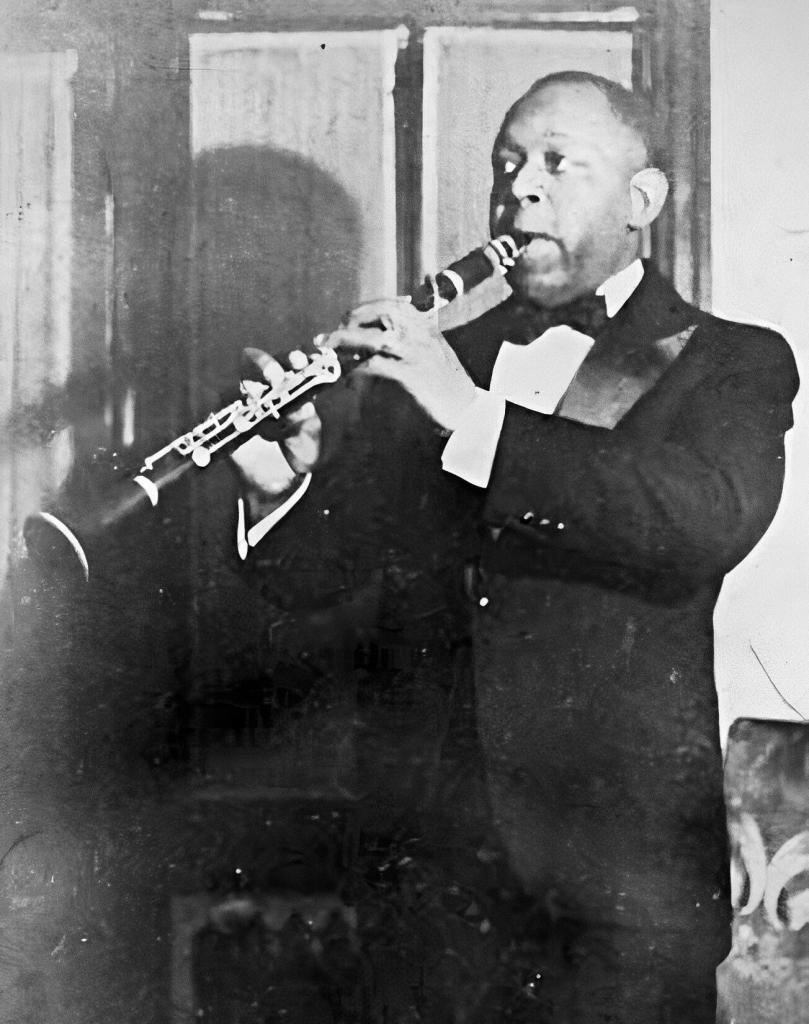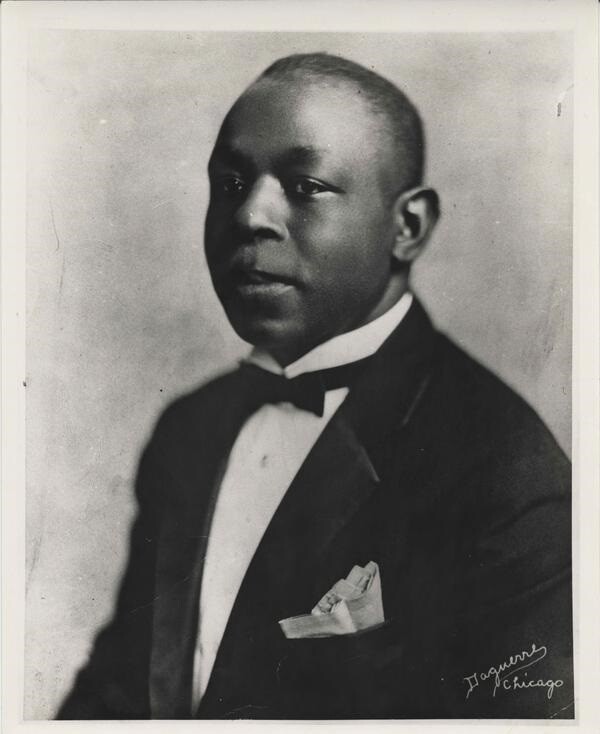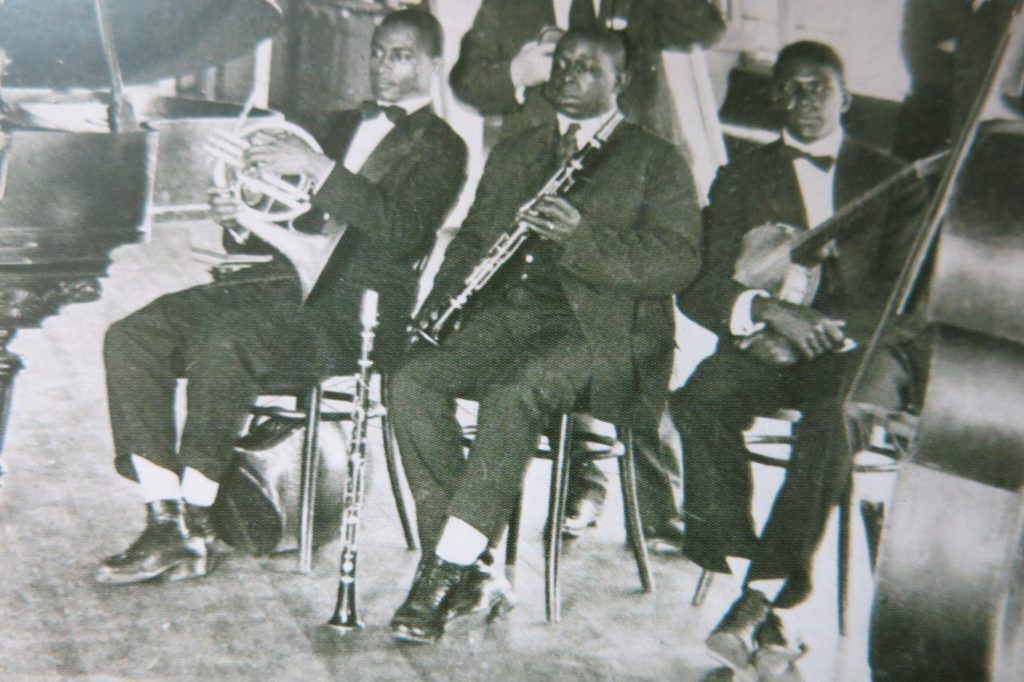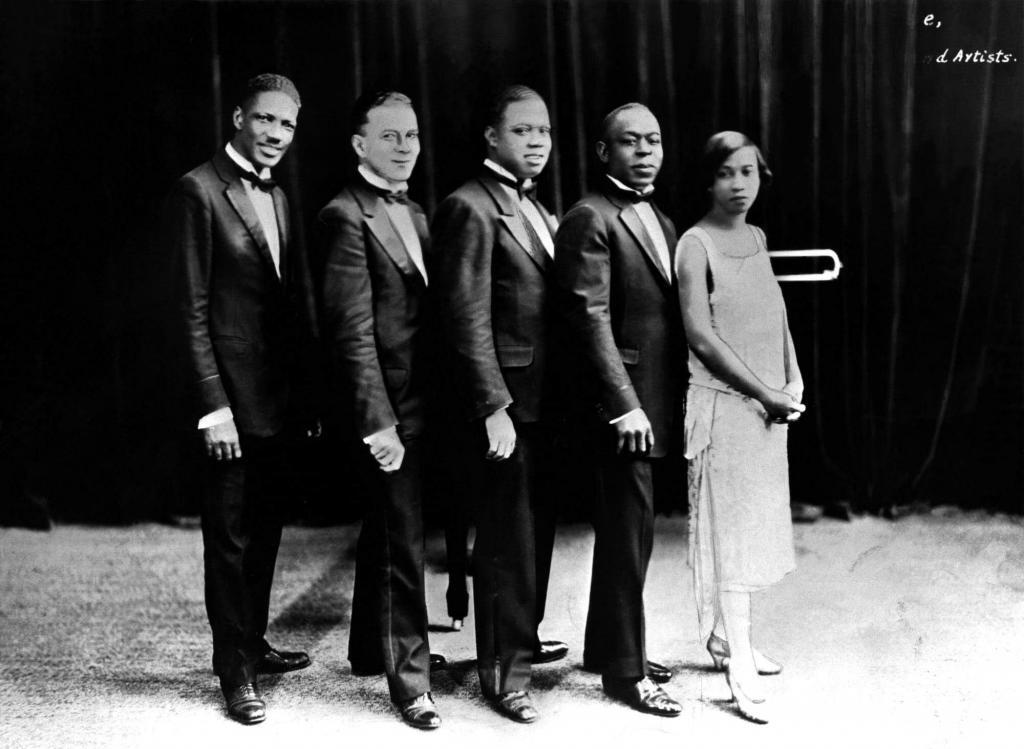Hal Smith: Jeff, since I suggested Johnny Dodds as the subject for our second column in The Syncopated Times, I would like to select the first side for our discussion. My choice is “House Rent Rag” by the Dixieland Jug Blowers. This was actually the first record where I could hear Johnny Dodds clearly. He was already boiling under the ensemble when they started playing at the end of that mock-sermon, and when he played that first break—it was like a bolt of blue lightning shot out of the speaker. It was so thrilling to hear, and I loved the way Dodds kept playing hot, bluesy clarinet all the way to the last bar. My hat is off to whoever came up with the great idea to bring in Johnny Dodds to play with the Dixieland Jug Blowers for that session. This record made me a Johnny Dodds fan for life.
Jeff Barnhart: Great start, my friend. I went back to that cut and sat through the hokum that leads up to that marvelous break by Dodds: in that single moment, jazz overcame the hoe-down flavor of what preceded it. His second break on the next chorus is just as thrilling. At that time, Dodds was the instrumentalist most in-tune with bending the notes he was playing, both influenced by, and influencing, the blues vocalists of the day. His was an almost human wail. It’s illustrative how he remained distinctly true to his “voice” no matter the make-up (or quality) of the groups in which he recorded—and led.
Let’s stay with 1926 and listen to “Little Bits,” a trio recording by Jimmy Bertrand’s Washboard Wizards that is remarkable for several reasons—besides a washboardist being listed as leader of the date (no offense, Mr. Smith—you yourself play a mean washboard).
Dodds never gets a break—talk about stamina. Even though the piece is pianist Jimmy Blythe’s composition, Dodds makes each section his own with his phrasing and transitions between choruses. This was (way back when) my first encounter with Dodds, and it had the same effect on me as you described above. I listened to the final two bar tag dozens of times in a row. Any thoughts about this recording, Hal?

HS: I can hear why this one made such an impression on you. On that particular side, Dodds was playing in the old New Orleans tradition of “no taking down” (i.e., all ensemble), and with unflagging creativity from beginning to end. His musical colleagues on that record are two of my favorites: Jimmy Blythe on piano and Jimmy Bertrand on washboard. Under other circumstances, I would be upset that neither of them were given any solo space…except that Johnny Dodds played with so much spirit and inventiveness that he deserved to be the only solo voice.
This next one is unusual, since much of the material Dodds recorded was either original compositions, or songs written by fellow musicians like Natty Dominique or Jimmy Blythe. With very few exceptions, he really didn’t record many popular songs. “After You’ve Gone” is one of those pop tunes, and Dodds’ low-register chorus comes close to making it into a blues. What a contrast to all the recordings of the song where the clarinet is in the upper register, playing cascades of notes at tempos that would make a metronome overheat.
JB: Yeah, man! So soulful. Even in his “double-time” break, Dodds avoids both pyrotechnics and gimmicks. The final ensemble, with the tight brass figures, is dominated by Dodds and his mournful counterpoint in the dark, chalumeau register. It’s a very moving performance.
Brother, I am having a tough time narrowing down gems to discuss. We could devote an entire chapter on the intro and opening chorus of “Perdido Street Blues,” or to covering the best version of Johnny Dodds’ Black Bottom Stompers (with Dodds, Louis Armstrong, Roy Palmer, Barney Bigard, Earl Hines, Bud Scott and “Baby” Dodds) during their session of April 22, 1927. In fact, let’s use that session as a springboard for looking at the two versions of “Wild Man Blues,” recorded two weeks apart, during which Dodds and Armstrong are the only soloists.
Much ink has been spent on contrasting Armstrong’s work on these sides (i.e. cornet in April vs. trumpet in May; competent in April vs. cosmic in May), but Dodds shows great versatility between versions as well. He is more subdued in the April session under his leadership; in fact, his chorus seems to be a musical pas de deux between clarinet and piano with Hines’ elaborate (but gorgeous) accompaniment: one wishes there had been more opportunities for Dodds to record with Hines.
The same arrangement was recorded on May 7, and again, Dodds begins by quoting the melody. However, he dramatically alters his tone and ideas (such bending of notes here.) to match the bravura Armstrong has just provided during his solo. What a fate to have to follow Louis twice in two weeks on the same tune and try and keep up: Dodds does a damn good job. Does anything jump out at you when you listen to these two sides back-to-back?

HS: Dodds certainly was accommodating to Louis. He cut his own solo short, so that Louis could have a full chorus. I agree with you that he sounds somewhat under wraps on the Black Bottom Stompers version of “Wild Man Blues.” Maybe he was distracted by the great piano accompaniment by “Fatha.” The more well-known recording by the Hot Seven has a fantastic clarinet solo. He was fearless in following that masterpiece of a solo by Louis, and playing such a memorable chorus of his own. And I really admire how Dodds was able to achieve such a lovely, full tone even while negotiating those double-time passages.
You know, he made two more records of this song, Jelly Roll Morton’s Red Hot Peppers in 1927 and with his own “Chicago Boys” in 1938. The Morton record, in particular, is a showcase for Dodds’ low register playing, his part playing in the ensemble and more of those expertly-played double-time breaks.
As you said, we could go back and forth endlessly on “Perdido Street Blues” (or any of the New Orleans Bootblacks and Wanderers sides). I’m going to bypass those sessions altogether for the next track: “Lady Love” by the Chicago Footwarmers. Dodds’ arpeggios add a lot of texture to the front line, since the melodic line has so many half-notes and Natty Dominique and Honore Dutrey play relatively straight in the opening ensemble.
At the beginning of the clarinet chorus, Dodds sounds like he is about to start wailing, but almost immediately he goes to the lower register and brings the intensity down to a simmer. That changes, however, right after his brother’s washboard break. Dodds comes back in blazing-hot, and keeps the heat turned up until the end. Although it’s tempting (for me, at least.) to focus on Jimmy Blythe’s piano, Bill Johnson’s bass and Baby’s washboard, what about the clarinet playing stands out for you?

JB: I’m so glad you brought “Lady Love” to the table, Hal. Before I comment on Dodds’ awesome contribution I, too, have to give a shout-out to pianist Jimmy Blythe; his solo chorus on the verse simply rocks. Perhaps he was inspired by the awesome break that Dodds takes midway through the first ensemble chorus. I know it makes me sit up straighter every time I hear it. Dodds really knew how to capture the listener’s attention with his expert use of contrasts, especially when he had inspiring material: this tune is such a great one to play with a soulful melody and terrific chords to chew on.
My last selection finds Dodds offering up some more ensemble genius, this time in the Armstrong Hot 7’s blistering version of “Willie the Weeper,” from the same date as “Wild Man Blues.” Although his solo contributes more than its fair share of heat and “blue” notes, his playing around Armstrong’s most-likely worked out lead on the final chorus helps make this one of the finest examples of uncluttered, yet hot New Orleans—or should we say Chicago, as this and all of Dodds’ output was recorded in the Windy City—style polyphony ever to hit my ears. In bar seven of that final chorus, Dodds hits a high, wailing note that is the hottest part of the whole recording! I love his playing throughout this romp…in fact, I’m going to go listen to it now.
OK, I’m back…ready to hear your comments about my final choice, Hal, and then I have a surprise question.
HS: I agree with you about that last chorus. (Though the clarinet solo is pretty fantastic too; full of Dodds’ characteristic phrases and it sounds like he has so much music in his head that he can barely get it through the horn). On the out-chorus, the high “wailing” note you mentioned really shifts the gears into “Hot.” That reminds me so much of the Bob Helm’s choice of “wailing” notes when he played with Lu Watters, and also Mike Baird’s wonderful clarinet work with the South Frisco and El Dorado Jazz Bands.
JB: Yessir. Helm and Baird are great references to make, and your doing so leads me to my question: Who are other contemporary (or near-contemporary) reed players around the world who you hear deeply influenced by Dodds? There are many who include some of his trademark licks and ideas in their arsenal, but I’d like to hear your shortlist of those who like to dig deep into the “blue” Doddsian style when they play.
HS: First, we should acknowledge one of Dodds’ disciples who interpreted his music brilliantly, even while the master was still active. That’s Frank Teschemacher. Though he was also influenced quite a bit by Jimmie Noone (and Bix, and Louis), when you hear “Tesch” on recordings such as “Prince of Wails” and especially “Wailing Blues” and “Barrelhouse Stomp,” there can be no doubt regarding one of his main influences. Later on, Cy Laurie was a Dodds man in the UK, and Reimer von Essen was a Dodds disciple in Germany—while so many other clarinetists were following George Lewis. In the US, besides Helm and Baird, I have heard Ellis Horne, Walter Sereth, William Carter, Frank Chace, and Ted Bielefeld really dig into the style. Andy Schumm does too, when he switches to clarinet. And when Matthias Seuffert plays Dodds style, it will send a chill up your spine.

Jeff, on your overseas tours, have you encountered other young musicians who have been inspired by Dodds?
JB: Young and seasoned both, Hal. In the UK there’s Ewan Bleach, John Maddocks, and the grand old man of Doddsian clarinet (and Bechet soprano), George Huxley. In France, you can find Aurelie Tropez among other young disciples. I’m sure our readers can come up with other names we’ve not included here. Johnny Dodds’ legacy will continue on for a long time to come. Hal, how about we look at various recordings and interpretations of “Twelfth St. Rag” for our next column?
HS: That sounds good. Count me in!
Visit Jeff Barnhart’s website (www.jeffbarnhart.com) and Hal Smith’s (www.halsmithmusic.com) for information regarding recordings and upcoming engagements.
Also See:
Johnny Dodds: His Teachers and Clarinets, by Christopher D.K. Cook
Johnny Dodds (1892-1940) in the Red Hot Jazz Archive
The Legacy of Johnny and Baby Dodds: Profiles in Jazz, by Scott Yanow
Hal Smith is an Arkansas-based drummer and writer. He leads the El Dorado Jazz Band and the
Mortonia Seven and works with a variety of jazz and swing bands. Visit him online at
halsmithmusic.com























